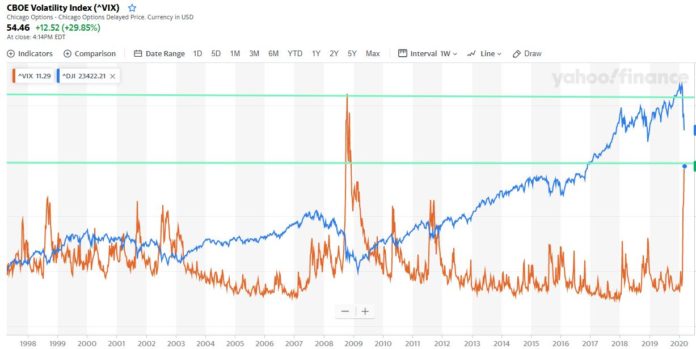Is There a Pattern of Recovery After the Market Crashes and the VIX Spikes?
I think there may be. Historically, there have been a relative few number of instances when the Volatility Index has risen above 30. And right now is one of them. For most of the drops, as I see it, the recovery time to reinvest tends to be about 7 weeks after the initial VIX spike. Obviously not entirely accurate for each instance, after the 2008 bank collapse, for one. Still, here is my (mostly unqualified) analysis and reasoning for this predictive behavior based on times past when the VIX spiked over 30.
Too Scared to Lose: Good Analysis from a Terrible Investor
Yes, I have a terrible track record when it comes to investing. I should be a millionaire in about 5 years according to my original plan. A plan based on markets that are volatile. Buy low, sell high, buy low, sell high.
Except, that’s not how I do it in real life. I’m just as fearful as the next sucker who wants to be robbed of his cash by a bunch of greedy rich guys who love “opportunities” — that is, opportunities to take our cash at the worst times and turn it into digital gold. Yes, I have a terrible feeling after I trade that I goofed, and I should undo what I just did, and then I wait through the lows, and buy again when the stocks have nearly recovered all that they lost. And then, I try it again, and goof it up again. And then I just sell and let most of it sit on the wayside. The primary driver of my fear is that I don’t have a whole lot at the end of the day to invest. I can’t afford to play around. Okay, the “World’s Worst Investor” is probably not me, but honestly, if I had stuck to my own “gut” advice instead of second guessing, quadruple guessing and then sitting out, I would have made much more cash.
So, I’ve been saying for about 8 weeks that this Covid-19 infection looks like serious business. Based on the videos coming out of China — the oppressive ones where people are dragged out of their homes, the ones of people falling down in the street, the ones where people are boarded up like they are the “Don’t Open, Dead Inside” zombie warnings. And as other nations caught the coronavirus infection, and the first wave of stock market tumbling happened, I said out publicly:
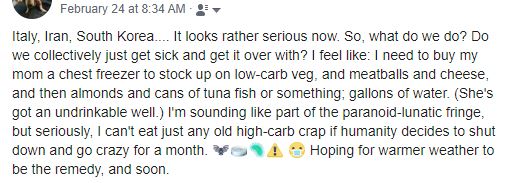
The panic buying began immediately — toilet paper, pasta, hand sanitizer, and face masks were disappearing from store shelves at a rapid rate in certain markets in certain countries.
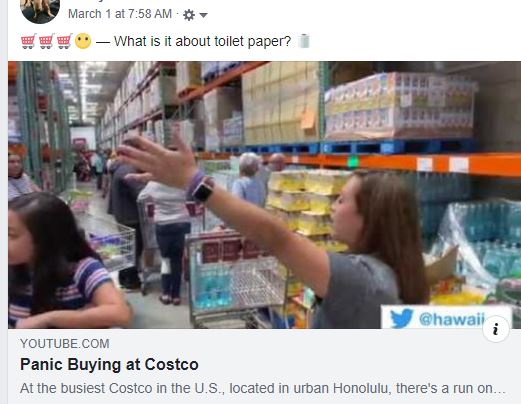
So, let’s back up a couple of months, maybe a few years. The market has been “very good” under Trump’s administration. From the moment he got elected in November 2016 to February, 2020, the market had shot up and up. The Dow from about 18,200 to 29,400 — an increase of 61.5% in 3.5 years (or 17.6% per year). Now, the average Market return historically has been like 7% . So, for whatever reason, “irrational exhuberance” has returned to the fore.
I was really uncomfortable with these numbers at the end of 2019, and I sold a decent chunk of my equities on December 30-31. I kept Google and Amazon, because they can decline, but their value is pretty good and solid overall. I knew something would happen pretty quickly, but I did not know what. And so, I just let it sit there. The DOW was at about 28,800 then, and it kept going up … briefly. I felt like I’d made a mistake, but no, the market did not seem “real” and all the talking heads on CNBC and elsewhere were claiming Trump is a genius and the economy is good. Democratic presidential candiates were grilled: “With the economy doing so well, how are you going to convince the voters that you should be President?” Bernie Sanders, for one replied: “For the average American worker, wages have not gone up. They do not own much in the way of stock investments. And they have little left each week because they live paycheck to paycheck. The economy is good for billionaires and Wall Street. It is not good for the Average American.” In light of the “the highest record highs” of the Market, Sanders came across as genuinely speaking for struggling Americans but almost blind and dismissive of “the reality.” (Personally, I’m with Sanders on his points there.)
And then the news of coronavirus got real. And investors started to pull back. The market took a hit, recovered and well, it tanked today 2,000 points on the DOW. Now, having said and posted all I did before: Did I sell on my good sense “gut feeling?” Nope. I thought, again, I’ve made so many mistakes before, just ride this one out. And so I will. But I have all this cash sitting in the retirement account not doing anything. And now my “gut” is saying, “blood in the streets” it’s time to take a look at this crazy Greedy Beast again.
Well, there’s no real pattern to the stock market. So, to look for one is kind of folly. There are short term indicators, but no way to “time the market” or get it right anything close to 100% of the time. Still, we ding-dongs keep trying. “Dollar cost averaging” may work very well long term, but it is so unexciting.
About 6 months ago, there was an “early warning of doom.” In August of 2019 we witnessed “The Inverted Yield Curve.” All of the know-it-alls rushed out to explain that this phenomenon was an indicator of a recession to hit the Market in the months to come. Well, that made a splash for a week or so, and quickly dissipated; with the CNBC crew relentlessly mocking the notion that a recession could ever happen. Okay, I hate that channel — the people they put on air there are perpetually pushing the trustworthiness of the free market and yet they say: The market is great, but it’s bloated, and it will probably go down, but it will probably go up. Bunch of nonsense from a group of arrogant men looking for attention. Granted, some of these people are very wealthy and know how to run a business way better than me. So, Kudos to some of their guests, but the “new hosts” are a loathsome circle of — I don’t know what. Anyhow, they love to say: “We were right, and I told you so.”
Skip Forward Already — VIX. VIX. VIX!
So, yeah, the Volatility Index is having one of those rare moments when it shoots above 30. And in those rare moments is an opportunity. Whether it is smart to jump right in or to wait a little while — I don’t know. That was the point of this post.
I’m going to chunk the market history into the past few Presidential eras. And take a look at what happened, and how quickly the market turned around from a high volatility moment.
Poppy Bush
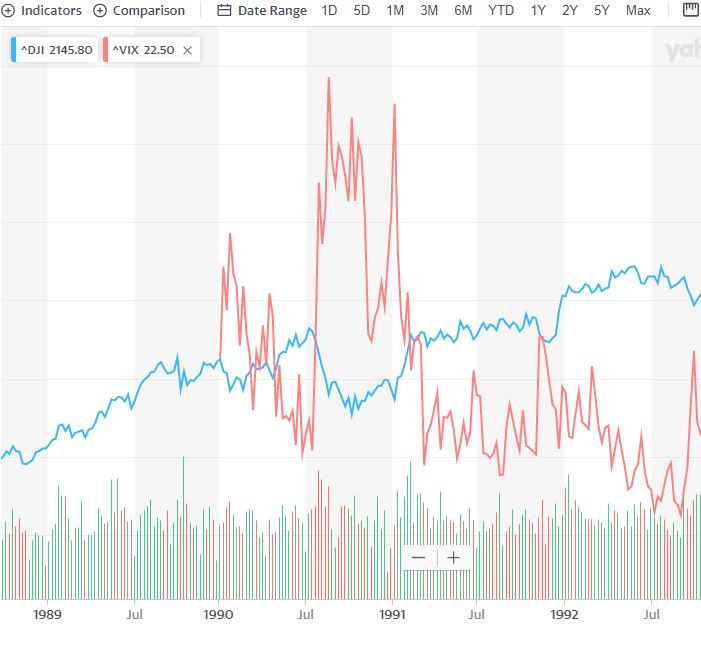
The VIX started in 1990, so only two years to analyze here. The primary peak (VIX: 29) seen above represents the day George HW Bush started The Gulf War. The low point in the DOW dip is about 6 or 8 weeks after the initial invasion. A second peak (VIX: 21), oddly enough, was the begging of the recovery. Bush essentially “won” the war against Iraq rather quickly but pulled out due to the whole “You break it, you bought it” truism. Unfortunately, for him, his popularity dwindled during the 1992 election (because he couldn’t tell you what a loaf of bread or gallon of milk cost). He seemed out of touch, and Bill Clinton, governor of Arkansas was elected.
Slick Willie
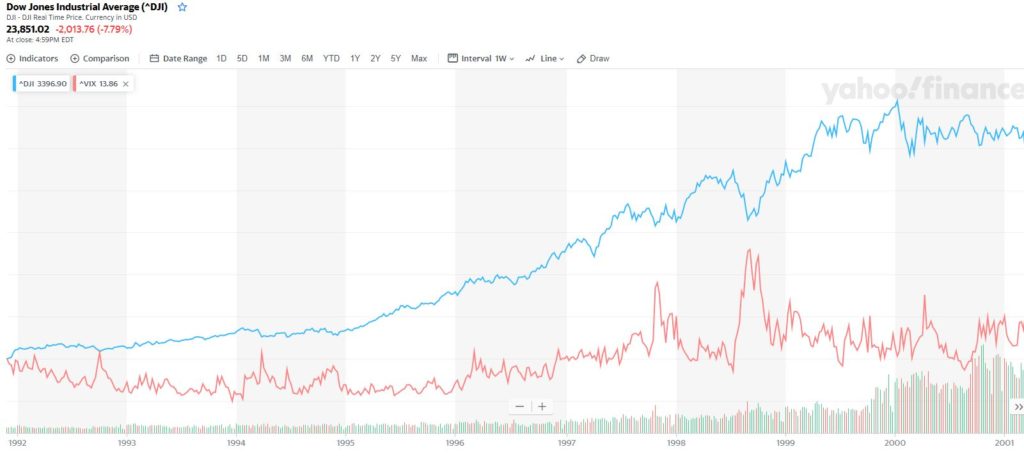
Bill Clinton, the saxophonist, was brought in on a wave of Democratic optimism. And it quickly fizzled as his policies seemed “radical” at the time, and his wife, Hillary Rodham Clinton, was criticized for her “unelected role” in trying to craft a healthcare for all bill. Also, his support for gay rights was quickly undermined by conservatives and Republicans and bible-thumpers; resulting in Defense of Marriage Act and Don’t Ask Don’t tell. Two of America’s most shameful, discriminatory acts which took many years to overturn; yet Clinton signed it and engendered himself to be “the great compromiser.” The DOW started at about 3,300 and ended eight years later around 11,000 — a huge rise of about 333% (41.6% per year).
Wow, what happened there. It was going all right for the first couple of years, and then the world entered the digital age. The Internet, the World Wide Web and America Online changed everything that could be changed. Email, online shopping and sales, company websites and from dial-up internet to always-connected ISDN. The Earth and all her people changed so unbelievably rapidly, and entire new lines of work opened up and online stock trading was suddenly available to everyone … for a little per-transaction fee. At the same time, pensions almost became extinct and 401Ks became the new vehicle for retirement savings as well as Roth IRAs. What to do with the money in these properties? Why, put it in the stock market, of course. So, it’s not so much that Clinton fostered this good times of the 1990s, but rather that he was in the position of power during this digital revolution.
The VIX mostly stayed around 13 for most of the Clinton era, until the 1997 and 1998, when these marvelous internet start-ups valuations started to be questioned. The first sign of trouble came in October of 1997 — a “mini crash” occurred (VIX: 29) allegedly because of some kind of Asian crisis. The low before the rebound occurred on the first day, but then again about 9 weeks later.
August 1998 (VIX: 34), the technology stocks took a turn for the worse. The low point was pretty immediate within a couple of weeks, and then by the end of September, just 4 weeks later, the 2nd low before the recovery began. And the recover was pretty spectacular for the next year. Clinton was dogged by the Republicans for nonsensical issues. However, several women claimed to have been victimized by the President before he entered office; and it was a White House intern that led to Clinton being impeached for lying to Congress at the end of 1998. He stayed in office and only became more popular — sort of. Between April 1999 and the election of 2000, stocks remained flat. And Al Gore lost to George W Bush, because people had had enough of the Clinton era, and, oh, Dubbya stole the election with the help of Florida election officials and their idiotic “hanging chads.”
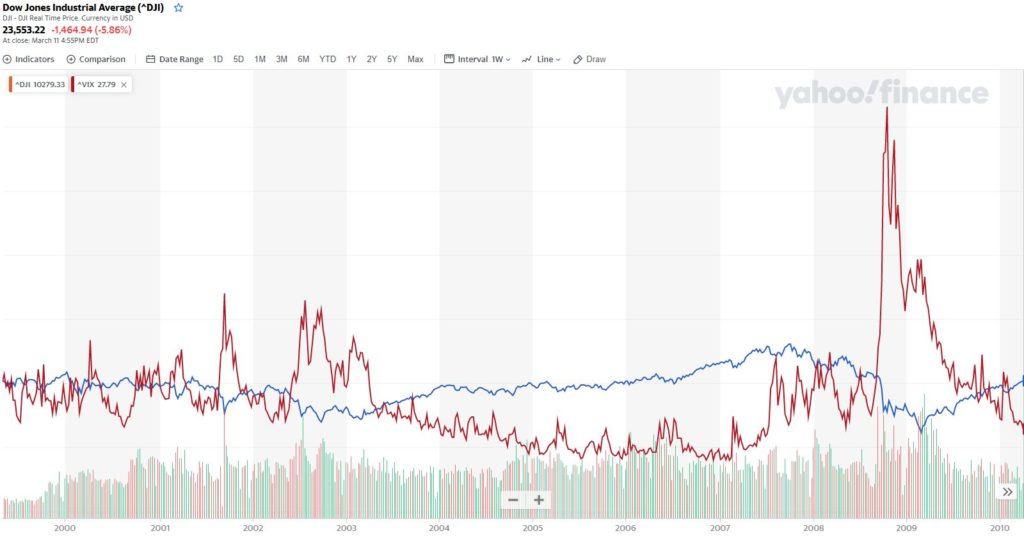
Dubbya and the T*rd Blossom
George W. Bush ushered in an era of mediocre political leadership coupled with vicious messaging and a whole lot of lies as concocted by his chief political adviser, Karl Rove. The pivotal moment of crisis that defined most of his presidency was 9/11 — September 11, 2001, the day that domestic planes were used by terrorists (mostly Saudis) to destroy the Twin Towers of New York City and part the military’s own headquarters — the Pentagon outside of DC.
The markets were halted almost immediately, and did not resume until a week later. This emergency move may have been a smart thing to do. The DOW dropped from 9,600 to 8,350 of the week after September 17 (VIX: 43). That seems like a smaller percentage drop than it would be have been had the markets been allowed to continue. But, since the planes directly destroyed much of the NYSE’s home turf, and sent financial experts running for their lives, it is quite remarkable that things were not worse for the markets. The market started its recovery almost immediately afterward, and no dramatic dip was seen for a while.
In the summer of 2002, from May (VIX: 36) to August, another scandal of valuations occured — most notably with a company called Enron, and also a lot of tech companies that had no effective working business models. The DOW dropped from 9,400 to 8,700 in a few weeks, and then dropped again September 29, 2002 to 8,300 (VIX: 33), and again and again over a long series of volatile movements. The market hit another low in February 2003 (VIX: 31) did not begin to recover until the March 2, when the DOW was DOW to 8,700 again. On May 11, 2003, the volatility dropped down to fairly normal levels (VIX: 19) when the DOW was at 8,600.
The market enjoyed a great run for 4 years then, with the DOW rising to 14,000 in May 2007.
Bush had begun his war on Afghanistan in October 2001, but expanded his effort to control the middle east and exact revenge on the powers there, most notably against Saddam Hussein “who tried to kill my daddy.” Using a bunch of falsehoods about “weapons of mass destruction” to drum up support, Bush’s war against Iraq was basically approved of in October of 2002, but did not begin until March 2003. Apparently, Wall Street and the American public approved of this in the beginning.
The markets rose steadily for about 10 months, and then flat lined for several years as the war continued. The idea of home ownership mass consumerism were promoted heavily, and the volatility dropped a lot (VIX: 11-14) as people began to feel like the country was in a stable financial position. However, as the war dragged on, and people began to grow extremely tired of the Administration’s lies about the war and Dubbya’s popularity plummeted.
As a result, Bush abandoned his “T*rd Blossom” buddy Karl Rove. Oil rose to $80 and “credit concerns” began to emerge in August 2007 (VIX: 17). The proliferation of subprime mortgages became a dirty secret and the financial firm Lehman Brothers collapsed on September 21, 2008 (VIX: 79). Pretty soon, all kinds of mayhem and chaos came to light and the market plunged. The DOW plunged from 11,500 to 7,500 by November (VIX: 59). And George W. Bush lost virtually all of his credibility, all of his creditable stock market gains, and so, Bush opted not to run for reelection. The successive royal Republican candidate, Senator John McCain, lost his bid to the previously unknown Democratic Senator from Chicago, Illinois: Barack Obama.
[Took a break here from writing this for a week.]
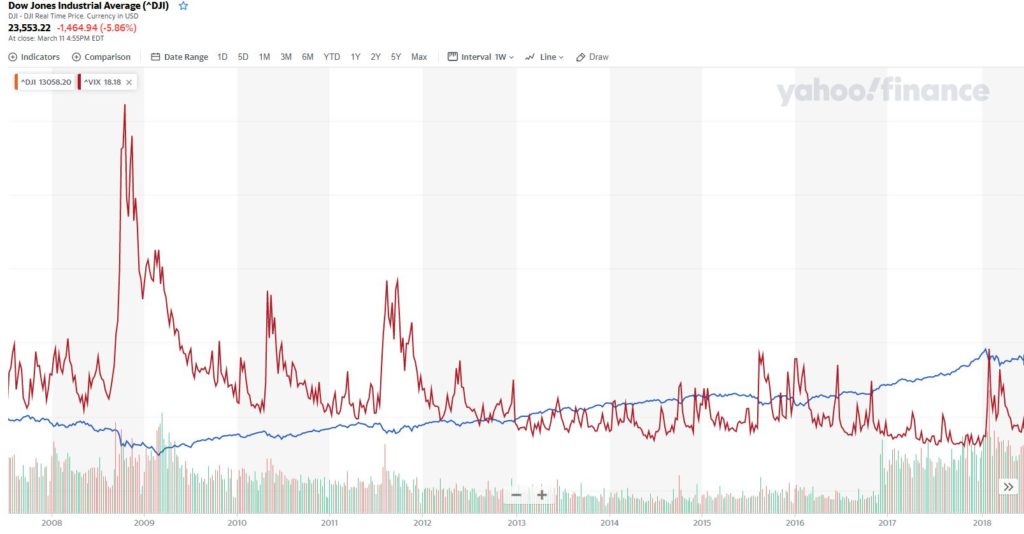
Rise of Obama
There’s a notion that the stock market tends to do better under Democrats than Republicans. And if that is to be believed, then perhaps Barack Obama’s legacy bears lends some credence to that assertion. To be fair, as Republican Bush was leaving, the market was collapsing, so all it could do under Obama would be to recover, and indeed it did. The VIX stayed very high for about 2 months and the DOW hit a low at the end of February 2009 of 8,100 (VIX: 49). That marked a drastically different trend from what had happened in past spikes. The market continued to fall for 4 months after the first spike, with something of a fake-out dip in the VIX that happened in 4 weeks at the end of December (VIX: 79 down to 43).
The VIX mostly died down after a huge bailout went into place and many acquisitions occurred in the banking industry. Really it was a terrible and expensive way to fix the situation but between Dems in the Congress and Bush’s capitulation and Obama’s corporate-friendly approach, the bailout was the solution that happened. And the market responded positively for 2 years, up to 11,000 (VIX: 22), through April 2010.
In May 2010 (VIX: 40), there was a new threat to the market — a Flash Crash, where the market dropped 9% in half an hour. It was the product of a single individual in London manipulating the algorithms to respond negatively from his lone computer, or so the story goes. The market was nervous until 8 weeks later, when it resumed its optimism.
The next bout of volatility happened on Black Monday, when a credit crisis happened in July-August of 2011. The DOW dropped from 12,100 to 10,800 in about 3 weeks (VIX: 43). It took 7 weeks for the DOW to hit a low and began to climb again, though the VIX remained nervous for about 8 more weeks.
The remainder of Obama’s Presidency was pretty lucrative for the market overall. There were many months when the market moved sideways rather than up, and a couple of times the VIX showed nervousness (China slow down) but it never went over 30. Mostly the market climbed for 5 years to an incredible 19,000 on the DOW, until the election of Donald Trump over Obama’s successor Hillary Clinton in November 2016.
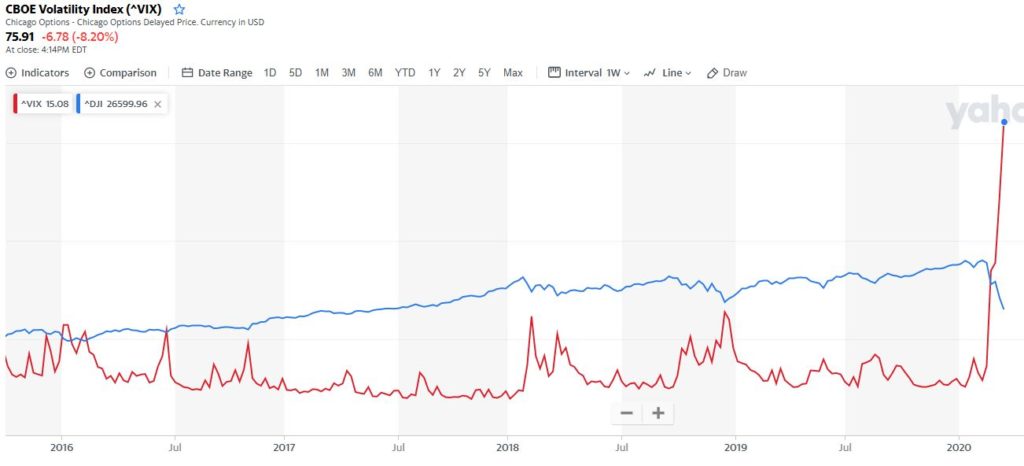
Trump, an Embarrassment of Riches
Just will not editorialize about Donald Trump much here — I don’t like him, and am on the side that believe he’s been a total embarrassment for the nation, and has coarsened the political discourse, and really did not deserve to be the President in anyway. But this is about the market, and so, he touted the market as proof of his accomplishments. And if one were to look at the days after the November 2016 election up until today, it has been an astounding gain in a relatively short period of time.
For 3-1/2 years the VIX has remained relatively low. Artificially low, in my opinion. And the gains seem artificially high. From the end of 2016 to February 2020, the DOW has climbed from 18,800 to 28,800 (+53%). This is mostly due to his huge tax cuts on corporations and the wealthy. Corporations were supposed to take their gains and turn that into cash for employees. Arguably, this hasn’t really happened at all — the companies did hire more employees due to the “good economy” but wages did not go up very much at all. Some worker wages raised, but more so because of the increases in the minimum wage were garnered by employee protests and Senator Bernie Sanders and other progressive politicians trying to embarrass companies into raising wages. Instead corporations using those huge tax breaks for good reasons, reports indicate that they used them for greed –mostly to do stock buy backs to inflate their stock prices. Hence, huge “gains” in the stock market. So, the perceived “value” of many of these companies isn’t necessarily due to dramatic increases in profits or productivity, but rather a reduction in investor ownership and an increase in value for the owners and payouts for upper management. Phony baloney.
And … boom.
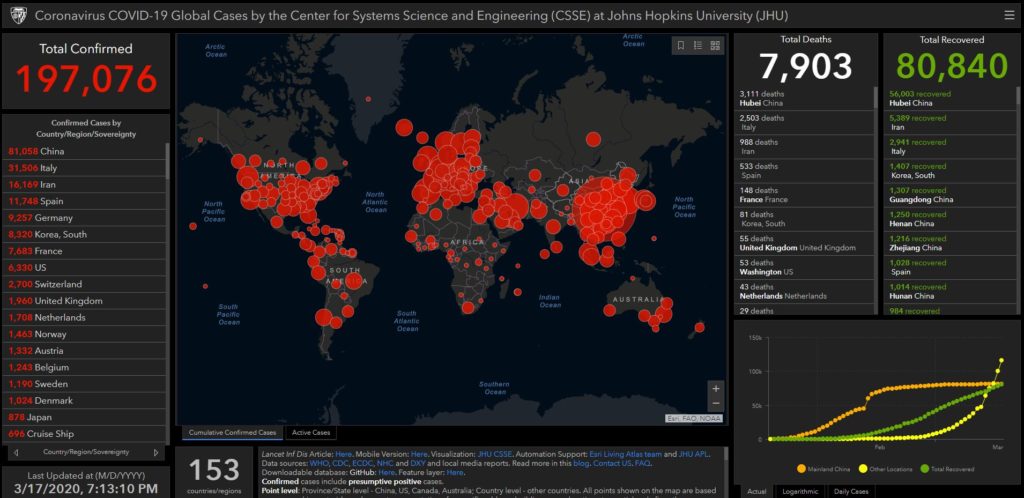
Coronavirus Crash ??
Then, we get to now — right now: March 2020. The stock market has crashed due to a virus that originated in China sometime in December 2019. The DOW dropped in 5 weeks from 29,000 in January to 20,000 (31%) today, March 17 (VIX: 15 up to 80).
So, that’s the highest high since the 2008 banking crisis crash. And this is just getting started in America. We have a lot of fear and panic buying happening, and concerns about elderly family members and people with pre-existing conditions dying. The world looks like it has a disease indeed on Johns Hopkins chart. The virus “escaped” China at some point at the end of the year, and seems to have been spreading to every country, and every state in the US in recent weeks. Italy’s health system is being devastated by the number of sudden cases.
Trump has been terribly unserious about the virus. Saying at first that the market was tumbling because people were afraid of the Democratic nominees for the upcoming November election. Then he claimed it was “like the flu” and would magically “all go away.” He even claimed, that America had like 15 people and it would be “down around zero soon.” Well, that was 6,300 confirmed cases. There’s been very little virus testing available to people. And so, faced with the gravity of the situation, Trump has “had to behave” like a decent human being. He is calling on Congress to fund huge relief and stimulus packages for the American people and businesses. Whether this actually gets to where it is needed is not likely in my opinion. We have already had one report that Trump tried to buy a potential vaccine from a German lab for a billion dollars. Very strange profiteering and control motivation. This is the world, the entire world that is dealing with this right now. This has never happened before. Now is not the time for selfishness, but rather a solution to slow the progress of the disease so that it does not overwhelm our healthcare facilities.
A series of regional proclamations have been issued by states and municipalities — begging organizations to cancel their large gatherings at first, and just recently to close all businesses that are not essential and to limit travel. There is even talk about imposing curfews! Starbucks, gyms, bars, restaurants — all closing up now.
Just this past Saturday, people in my DC neighborhood were crammed into bars for Saint Patrick’s Day along with the regular hip-hop madness that happens here every weekend. Some venues had closed out of good conscience, but others decided that they had to stay open to survive. This happened all across America according to numerous reports; and so, another round of restrictions occurred on Sunday morning. Basically, all social gathering places are to close in many localities — D.C., San Francisco, New York, Los Angeles, and on and on. Schools and universities are nearly all closing through the end of March, and probably going online-only for some time after that.
A week ago, I was speaking with my lab partners and the US tally was about to hit 1,000. It had been 60 a week before. Now it is at 6,420. This is something to behold for sure.
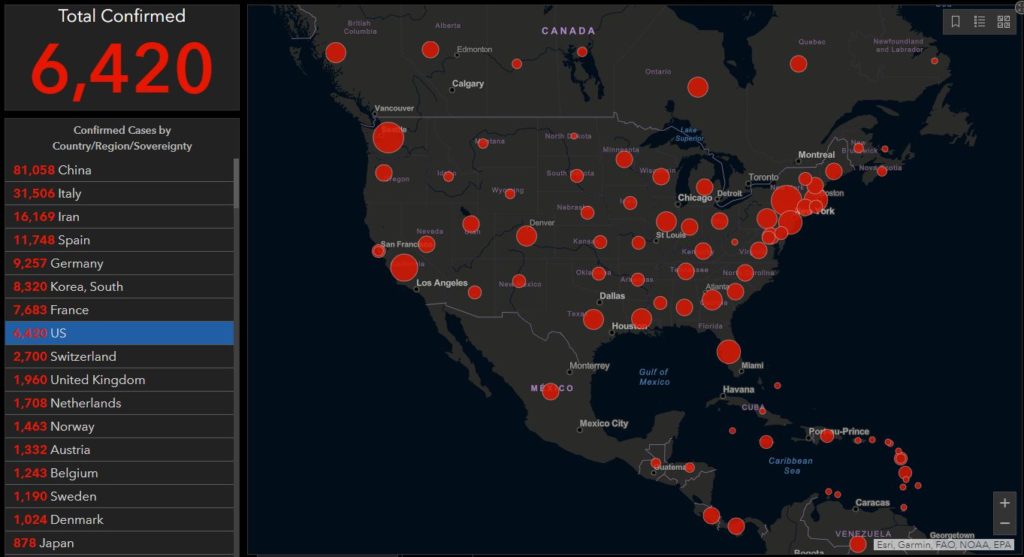
People do not have available money saved in this country. The service industry doesn’t tend to pay well, and so most people live from paycheck-to-paycheck. Their kids may be at home, too. Everyone is being told to stay put, and don’t leave home unless you have to for the next two weeks. It seems absolutely insane and is nearly unbelievable.
Not unbelievable to me, though, because I saw it coming from China (thanks YouTube), and even before that, I sold a good portion of my stocks on December 30 & 31 in anticipation of “something” going bad. But it wasn’t enough. I lost $20,000 easily and I don’t have a great deal saved for retirement — more than average, but not but a fraction of what I’ll need when I’m old. I cannot fathom how other people will deal with the loss of income, the bills still coming in, and the requirement to stay put indoors for a long stretch of time. It is not going to happen in my opinion. Really, I see the potential for a backlash and possible criminal activity rising in the urban areas. And unfortunately, many other people seem to be threatened too. Because, not only are they buying all the toilet paper, eggs and meat, they are lining up to purchase guns and ammunition, too. Terrible.
The good news is: Most infections are “mild” in their severity and about 15% require medical intervention. Also, that China has seen a significant slow down of new infections. And so has South Korea; and allegedly, Italy may be slowing down in its most affected areas. But other nations are projecting hundreds of thousands or even millions of possible infections with a 1% to 6% death rate. It’s too much to believe, really — in my opinion, this is mostly overblown fear. And for now, that’s okay, because if we are to get a handle on this contagion, something immediate and drastic does have to happen — everywhere. But as my YouTube doctor John Campbell said today: “There’s no end game.” Meaning, we are only treating the next couple of weeks of this viral outbreak with these stifiling measures. We may indeed slow the progress and “flatten the curve” enough that hospitals will not collapse. Banks will not collapse. Society will not collapse…. Not for two weeks.
But what happens after that? No clue. Well, if you ask me and my zombie-disaster-apocalypse movie-based education, I would say that people will want out of this agreement before March is over. That they will begin to rebel when the checks are not enough. There is food on the shelves (no toilet paper or hand sanitizer, still); but will stores be open for business, and will people be allowed to go out and get what they need? Will they have any money? I think people will get bored by the end of this month. And some will misbehave severely. And am concerned that some cities may have severe scenes of criminal destruction or mayhem. What happens then? The police and National Guard start using lethal force or mass incarceration? No, it cannot come to that — no, please, let’s don’t go there. The alternative option, as “there is no end game,” may be to accept that this is the new way of the world. The novel coronavirus of 2019 and CoVid-19 infection will likely be with us for some unforeseeable amount of time, and it will have an unforeseeable impact.
Conclusion: What about the Market? The VIX?
The long-winded point of this was supposed to be this: Historically, the initial panicked peaks of the VIX seem to be followed by a few weeks of uncertainty, and then a fairly rapid recovery. So, it may be 4 weeks to 8 weeks before a 2nd dip occurs and then the rebound happens.
But again, who am I to suggest what will occur? Just an observer.
I am buying back into the market now, but tepidly. I’ve lost some of that additional money already, yet made some extra, too. It is potentially lucrative in a rapid manner, but this game has not balanced out in my favor just yet. I am hoping that everything will be returning to relative normalcy in a couple months time. Wall Street will go back to being greedy, for sure — but all of this tumult will take months to burn itself out. Some portion of people will continue to avoid social gatherings, crowds, transportation and travel and entertainment venues. It’s going to be a long summer and another terrible election season. Good luck to us all!


